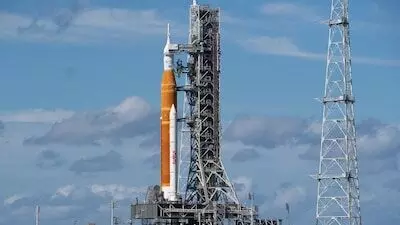
Countdown begins for NASA Artemis I Moon rocket launch, after two failed attempts
text_fieldsFlorida: Is the third time the charm? Less than a week after the enormous apparatus withstood a hurricane, NASA plans to launch its new mega Moon rocket early Wednesday from Florida after two failed attempts.
"Our time is coming. And we hope that that is on Wednesday, "Mike Sarafin, the mission manager for the much-delayed Artemis 1 mission, made this statement at NASA headquarters.
The US space agency's plan to establish a long-term presence on the Moon and learn from its experiences there to get ready for a future journey to Mars is being launched with the Artemis 1 mission, a test flight without astronauts, AFP reported.
The new space mission, which has the name of Apollo's sister in Greek mythology, was launched 50 years after the last time people stepped foot on the moon.
The Space Launch System rocket, the most potent NASA has ever created, will launch for the first time on Wednesday at 1:04 a.m. local time (06:04 GMT), with a potential window of two hours.
At the illustrious Kennedy Space Center, where the orange and white behemoth awaits its first flight, the countdown has already started.
Less than a week will have passed since Hurricane Nicole passed over the area where the rocket was set to launch.
For the time being, officials are assessing the potential of hurricane damage to a thin RTV-like strip that encircles and improves the aerodynamics of the Orion crew capsule mounted atop the rocket.
Teams are examining the possibility that the RTV can come undone during launch and cause issues.
If necessary, two alternate dates on November 19 and 25 are feasible.
Moon's far side
There is a 90% likelihood of favourable conditions during the launch window, and the weather is forecast to be mild.
The rocket had to be wheeled back to its assembly building at the end of September so that it could be protected from yet another hurricane, Ian.
Two launch attempts had to be cancelled due to technical issues prior to these weather setbacks.
A defective sensor caused the first failure, while a fuel leak while filling the rocket's tanks caused the second. It is powered by extremely volatile, extremely cold liquid oxygen and hydrogen.
Since then, NASA has replaced a seal and changed its procedures in an effort to minimise thermal shock.
Tank filling will now start on Tuesday in the late afternoon.
The launch is expected to attract about 100,000 spectators to the coast, and the rocket promises to light the night sky.
Two boosters and four strong engines under the core stage, which will separate in a matter of minutes, will push the Orion capsule into orbit.
The capsule will be well on its way after receiving one last thrust from the upper stage, and it will take many days to arrive at its destination.
It will take up a far orbit, travelling more than any other habitable spacecraft to date—40,000 miles (64,000 kilometres) beyond the far side of the Moon—instead of making a landing on the surface.
Orion will then start the return phase of its trip. The heat shield of the capsule must be able to sustain a temperature half that of the Sun's surface while travelling through the atmosphere.
The mission would begin Wednesday and end on December 11 with a splashdown in the Pacific Ocean after a total duration of 25 and a half days.
After spending more than a decade creating the SLS rocket, NASA is counting on a successful trip. By the end of 2025, it would have invested more than $90 billion (approximately Rs. 7,32,400 crore) in its new lunar programme.
In 2024, Artemis 2 will resemble the original mission almost exactly, but with astronauts.
The first woman and first person of colour to step foot on the Moon are expected to be part of the Artemis 3 crew, which is scheduled to launch no earlier than 2025.























